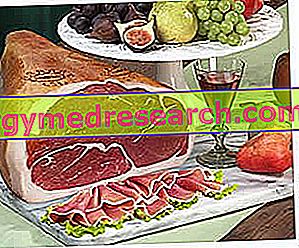Generality
The ham is a preserved meat, or better, a raw cured meat, NOT cured and almost completely coated.

NB. Often, raw ham is marketed in much smaller cuts (similar to slices) but they too are obtained from the whole and seasoned leg of the pig.
The production of cured ham is the result of salting (dehydration) and maturing of the leg of the pig; it is an extremely synthetic and apparently simple procedure (especially when compared to that of cooked ham) but remarkably delicate and with a high index of error.
Production
The production of raw ham occurs by:
- Selection of the thighs: first of all, it is necessary to specify is that that of the pigs for the production of raw ham is a "breeding in itself", or rather it deals with herds previously destined to this kind of supply chain; obviously, the rest of the animal is still used for food, BUT nutrition, lifestyle, veterinary care etc. are aimed at obtaining the thighs most suitable for the production of raw ham. In some cases, at the time of purchase, the animals are selected alive, while in others, the selection takes place on the already slaughtered thigh.
NB. The variables to be considered in the choice of the beast or thigh are different; the most important ones concern the dimensions and the level of fatness.
- Frolling of the thighs: it occurs for several days at a temperature of 3-4 ° C
- Salting of the thighs: the hams, to dehydrate and then mature, must be sprinkled with salt or immersed in the brine; the mixture used for salting raw ham contains: sodium chloride, flavorings, nitrates and, in some cases, sucrose.
NB. The salting rates are necessary for the success of the food
- Pre-rest and rest: phases in which the hams begin to change their nutritional composition and the percentage of water contained in them
- Washing: it is aimed at eliminating the external residues of raw ham (salt, liquids, impurities etc.)
- Drying / drying: in this phase the hams are passed into a special dryer to be carefully dried by excess liquids
- Sugnatura: as anticipated, the portion of uncovered meat and not provided with rind must be sprinkled with lard; this process is essential so that the raw ham is preserved "integrally" and does not present any perishable portion even near the areas without rind
- Grooming: very simply, the hams on top are then scrutinized and "corrected" before the next processing phase
- Pre-aging and maturing: phases of actual curing of raw ham that can only be successfully concluded if the previous steps have been carried out flawlessly
- Pointing: this is "the final examination" of raw ham; through tacking, a specialized operator checks the organoleptic properties of the food, the presence or absence of defects and evaluates its suitability for being placed on the market NB. The evaluation criteria are different based on the presence or absence of the IGP or PDO marks
- Marking: it lasts from 6 to 14 months (depending on the product to be obtained) and ONLY takes place in the case of achievement of the quality standards verified in the spot and required by the production disciplinary.
Risotto with Prosciutto and Melon
X Problems with video playback? Reload from YouTube Go to Video Page Go to Video Recipes Section Watch the video on youtubeNutritional characteristics
Prosciutto is a preserved meat.
The amount of sodium, total fat and calories vary considerably depending on the type of raw ham analyzed, even though they represent, on average, foods that are CONTRAINDICATED in the diet of hypertension and (the fatter ones) in the hypercolesterolemic or hypocaloric diet against overweight. On the other hand, by observing the content of saturated lipids and cholesterol of defatted hams, it may be possible to contextualize them easily even in diets with lower calories, saturated fatty acids and cholesterol.
As far as mineral salts are concerned, raw ham is a valid alternative to fresh meat and (as it is greatly appreciated) facilitates the achievement of recommended iron rations in fertile women. The quantities of potassium and phosphorus are also appreciable, while, from a vitaminic point of view, raw ham boasts good thiamine (vit. B1) and niacin (vit. PP) rations.
What unites ALL raw hams is the impertinence in the diet of the pregnant woman. This "special physiological condition" requires a level of food hygiene that is, to say the least, sublime and preventive towards parasitosis and / or food poisoning; such a requirement excludes the vast majority of raw foods, including raw ham.
The supply of nitrates contained in it should not be underestimated; these preservatives (added externally during salting) are related to the onset of carcinogenic nitrosamines and therefore, although it may be considered one of the most balanced cured meats, even raw ham should be used sporadically or occasionally.
Nutritional Values Raw Ham
Nutritional composition of raw ham - Reference values of the INRAN Food Composition Tables
| Nutritional composition for 100 grams of edible part Raw ham, mountain: | ||
 | ||
| Edible part | 100.0% | |
| water | 44, 8g | |
| Protein | 26, 2g | |
| Lipids TOT | 22, 0g | |
| Saturated fatty acids | - g | |
| Monounsaturated fatty acids | - g | |
| Polyunsaturated fatty acids | - g | |
| Cholesterol | - mg | |
| TOT Carbohydrates | 0.0g | |
| Starch | 0.0g | |
| Soluble sugars | 0.0g | |
| Dietary fiber | 0.0g | |
| Power | 303, 0kcal | |
| Sodium | - mg | |
| Potassium | - mg | |
| Iron | - mg | |
| Football | - mg | |
| Phosphorus | - mg | |
| Thiamine | - mg | |
| Riboflavin | - mg | |
| Niacin | - mg | |
| Vitamin A | 0, 0μg | |
| C vitamin | tr | |
| Vitamin E | - mg | |
| Nutritional composition per 100 grams of edible part Parma ham: | ||
 | ||
| Edible part | 100.0% | |
| water | 50, 6g | |
| Protein | 25, 5g | |
| Lipids TOT | 18, 4g | |
| Saturated fatty acids | 6, 15g | |
| Monounsaturated fatty acids | 8, 40g | |
| Polyunsaturated fatty acids | 1, 60g | |
| Cholesterol | 72, 0mg | |
| TOT Carbohydrates | 0.0g | |
| Starch | 0.0g | |
| Soluble sugars | 0.0g | |
| Dietary fiber | 0.0g | |
| Power | 268, 0kcal | |
| Sodium | 2578, 0mg | |
| Potassium | 373, 0mg | |
| Iron | 0, 7mg | |
| Football | 16, 0mg | |
| Phosphorus | 261, 0mg | |
| Thiamine | 1, 77mg | |
| Riboflavin | 0, 20mg | |
| Niacin | 5, 50mg | |
| Vitamin A | 0, 0μg | |
| C vitamin | tr | |
| Vitamin E | - mg | |
| Nutritional composition per 100 grams of edible part Parma ham, without visible fat: | ||
 | ||
| Edible part | 100.0% | |
| water | 61, 5g | |
| Protein | 27, 5g | |
| Lipids TOT | 3, 9g | |
| Saturated fatty acids | - g | |
| Monounsaturated fatty acids | - g | |
| Polyunsaturated fatty acids | - g | |
| Cholesterol | - mg | |
| TOT Carbohydrates | 0.0g | |
| Starch | 0.0g | |
| Soluble sugars | 0.0g | |
| Dietary fiber | 0.0g | |
| Power | 145, 0kcal | |
| Sodium | - mg | |
| Potassium | - mg | |
| Iron | - mg | |
| Football | - mg | |
| Phosphorus | - mg | |
| Thiamine | - mg | |
| Riboflavin | - mg | |
| Niacin | - mg | |
| Vitamin A | 0, 0μg | |
| C vitamin | tr | |
| Vitamin E | - mg | |
| Nutritional composition per 100 grams of edible part Raw ham, boneless: | ||
 | ||
| Edible part | 100.0% | |
| water | 53, 0g | |
| Protein | 26, 9g | |
| Lipids TOT | 12, 9g | |
| Saturated fatty acids | 4, 24g | |
| Monounsaturated fatty acids | 5, 76g | |
| Polyunsaturated fatty acids | 1, 59g | |
| Cholesterol | 66, 0mg | |
| TOT Carbohydrates | 0.0g | |
| Starch | 0.0g | |
| Soluble sugars | 0.0g | |
| Dietary fiber | 0.0g | |
| Power | 224, 0kcal | |
| Sodium | 2238, 0mg | |
| Potassium | 454, 0mg | |
| Iron | 1.2mg | |
| Football | 15, 0mg | |
| Phosphorus | 177, 0mg | |
| Thiamine | 0, 60mg | |
| Riboflavin | 0, 20mg | |
| Niacin | 5, 00mg | |
| Vitamin A | 0, 0μg | |
| C vitamin | tr | |
| Vitamin E | - mg | |
| Nutritional composition per 100 grams of edible part Raw ham, boned, without visible fat: | ||
 | ||
| Edible part | 100.0% | |
| water | 57, 8g | |
| Protein | 29, 3g | |
| Lipids TOT | 4, 6g | |
| Saturated fatty acids | - g | |
| Monounsaturated fatty acids | - g | |
| Polyunsaturated fatty acids | - g | |
| Cholesterol | - mg | |
| TOT Carbohydrates | 0.0g | |
| Starch | 0.0g | |
| Soluble sugars | 0.0g | |
| Dietary fiber | 0.0g | |
| Power | 159, 0kcal | |
| Sodium | 2440, 0mg | |
| Potassium | 495, 0mg | |
| Iron | 1, 3mg | |
| Football | 16, 0mg | |
| Phosphorus | 190, 0mg | |
| Thiamine | 0, 58mg | |
| Riboflavin | 0, 20mg | |
| Niacin | 6, 50mg | |
| Vitamin A | 0, 0μg | |
| C vitamin | tr | |
| Vitamin E | - mg | |
| Nutritional composition for 100 grams of edible part Raw ham, gambuccio: | ||
 | ||
| Edible part | 100.0% | |
| water | 43, 6g | |
| Protein | 26, 2g | |
| Lipids TOT | 22, 4g | |
| Saturated fatty acids | - g | |
| Monounsaturated fatty acids | - g | |
| Polyunsaturated fatty acids | - g | |
| Cholesterol | - mg | |
| TOT Carbohydrates | 0.0g | |
| Starch | 0.0g | |
| Soluble sugars | 0.0g | |
| Dietary fiber | 0.0g | |
| Power | 306, 0kcal | |
| Sodium | - mg | |
| Potassium | - mg | |
| Iron | - mg | |
| Football | - mg | |
| Phosphorus | - mg | |
| Thiamine | - mg | |
| Riboflavin | - mg | |
| Niacin | - mg | |
| Vitamin A | 0, 0μg | |
| C vitamin | tr | |
| Vitamin E | - mg | |
| Nutritional composition per 100 grams of edible part Prosciutto crudo, San Daniele: | ||
 | ||
| Edible part | 100.0% | |
| water | 42, 8g | |
| Protein | 28, 3g | |
| Lipids TOT | 23, 0g | |
| Saturated fatty acids | 7, 56g | |
| Monounsaturated fatty acids | 9, 81g | |
| Polyunsaturated fatty acids | 1, 95g | |
| Cholesterol | 69, 0mg | |
| TOT Carbohydrates | 0.0g | |
| Starch | 0.0g | |
| Soluble sugars | 0.0g | |
| Dietary fiber | 0.0g | |
| Power | 320, 0kcal | |
| Sodium | - mg | |
| Potassium | - mg | |
| Iron | - mg | |
| Football | - mg | |
| Phosphorus | - mg | |
| Thiamine | - mg | |
| Riboflavin | - mg | |
| Niacin | - mg | |
| Vitamin A | 0, 0μg | |
| C vitamin | tr | |
| Vitamin E | - mg | |
| Nutritional composition for 100 grams of edible part Prosciutto crudo, San Daniele, without visible fat: | ||
 | ||
| Edible part | 100.0% | |
| water | 61, 0g | |
| Protein | 26, 8g | |
| Lipids TOT | 3, 2g | |
| Saturated fatty acids | - g | |
| Monounsaturated fatty acids | - g | |
| Polyunsaturated fatty acids | - g | |
| Cholesterol | - mg | |
| TOT Carbohydrates | 0.0g | |
| Starch | 0.0g | |
| Soluble sugars | 0.0g | |
| Dietary fiber | 0.0g | |
| Power | 136, 0kcal | |
| Sodium | - mg | |
| Potassium | - mg | |
| Iron | - mg | |
| Football | - mg | |
| Phosphorus | - mg | |
| Thiamine | - mg | |
| Riboflavin | - mg | |
| Niacin | - mg | |
| Vitamin A | 0, 0μg | |
| C vitamin | tr | |
| Vitamin E | - mg | |



